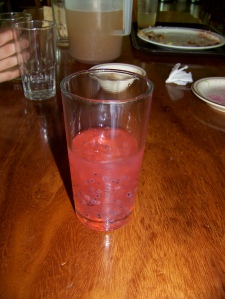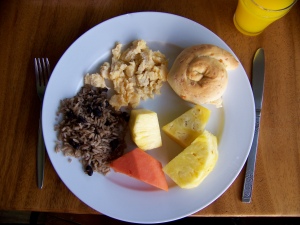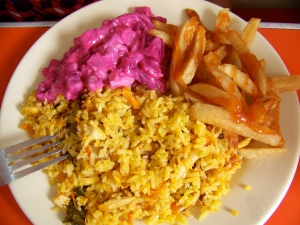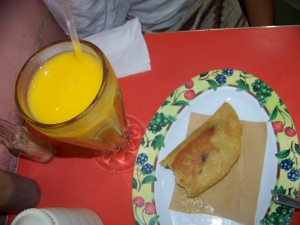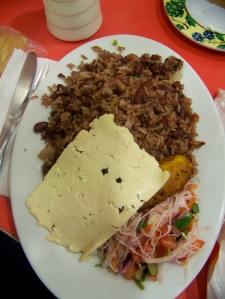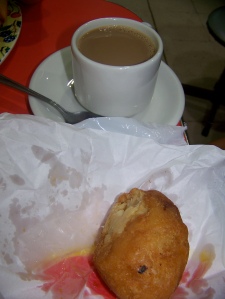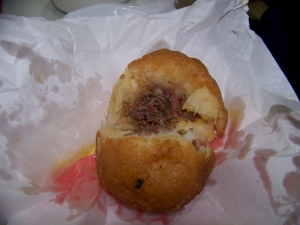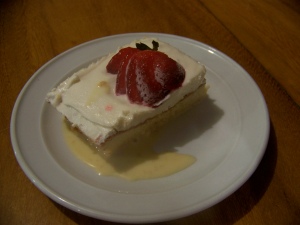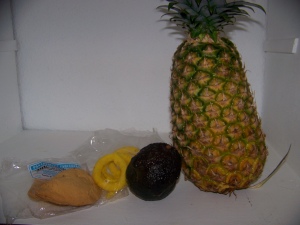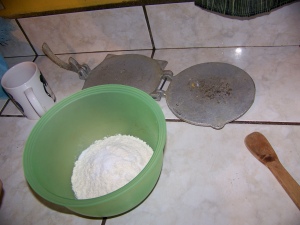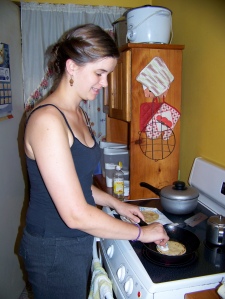When the topic of food comes up, I can go on for hours. Eating is a big deal in my house. Chances are that if you stop by to visit we are (in order of likelihood): eating, cooking, baking, or thinking about eating. If you step in the door to our house, you’ll probably be offered something to eat within the first 10 minutes (beware if my father offers, he’s becoming known for his strange collection of natural foods that he enjoys sharing). In any case, when traveling, the chances to be exposed to new food are very high, and I’ve certainly come into contact with many new foods in Costa Rica….
Fruits (a great place to start)
You can imagine that in the tropics, tropical fruit is nothing short of amazing. Though we can commonly find and buy pineapple (piña), banana (banano), and coconuts (coco) in the States, the ones here are much cheaper and much more flavorful. Also very common here are papaya and mangos. Fruits are frequently sold on the streets–I bought two gorgeous avacados (aguacate) a few days ago for 500 colones, for about 85 cents. I also bought three apples for the same price. The avacados are grown here, while most of the apples I’ve seen are imported from Chile. I also think that it’s amusing that despite having a huge variety of tropical fruits that are imported to the US from Costa Rica (can anyone say Chiquita?), there is also at least a small degree of reciprocality–all the peaches (melocotón) that I’ve seen have little stickers that say “USA”.
Also, although we seem to eat a lot of watermelon here, I must say that I enjoy the flavor of the watermelon in the States much more than here. It’s not bad here, just not as good as at home. Though perhaps my happy memories of watermelon are also linked to the memories of sitting in the backyard with my family, spitting the seeds into the grass. 🙂
There are many tropical fruits here that I have never encountered (or very rarely) in the US….mamón, plantain, jocote to name a few…again, sorry I don’t have pictures.
Also, instead of having what are referred to in the US as “lemon” and “lime”, there are the “limon” (which is what the word implies, a sort of a cross between a lime and a lemon) and “limon dulce” (which is yellow and reminiscent of what is considered a lemon in the US). Mandaríns are common, though much bigger than in the US. There are many orange groves, and the orange juice here is wonderful.
Many of the fruits are used for making refrescos and batidos. Refrescos are unsweetened (usually-add your own sugar) juices of just about anything with a drop of juice to be squeezed. They are sold everywhere, and we’ve gotten to sample quite a few of them, as they are served regularly with meals at the stations. Batidos are like milk shakes, though they can be made with milk or water, again with just about anything that can be considered a fruit or vegetable.
There is a particularly interesting refresco that it took me a few looks before I decided I would try it:
The little floaty things that look exceptionally like amphibian eggs are actually the seeds of the fruit that is used to make the drink (though I am not sure of the name of the fruit at this time). After questioning several times about the identity of the little floaty things, I tried it, and it’s now one of my favorites. Though I’ve never had “bubble tea” in the US, I’ve heard several people describe it, and imagine that drinking this refresco is similar to drinking the ‘bubbles’ in bubble tea.
So, what does a typical meal in Costa Rica look like?
This is breakfast:
Breakfast is awesome. Fresh fruit (varies depending on which area of the country–may include, but is not limited to: pineapple, papaya, bananas, watermelon, avacado), eggs, bread, and gallo pinto.
Gallo pinto is a very Costa Rican dish, and the Ticos are very proud of it. However, if you are anywhere with both Ticos and Nicos (Nicaraguan natives), you do not, under any circumstances bring up the topic of where gallo pinto was first made. There have reportedly been many arguments over who “discovered”/”invented” this tasty and filling breakfast dish. Gallo pinto is made over the course of a night and morning. The beans and rice are cooked separately the night before, and then cooked together the following morning with onions and cilantro (here, culantro). Gallo pinto is a traditional breakfast dish.
This could be lunch:
I got this when out one day. Another great thing about traveling in Costa Rica is that it’s insanely easy to get a filling meal for less than $3. This lunch was ~$2.54, including a refresco. It consisted of rice with chicken (arroz con pollo), French fries (papas fritas, literally “fried potatoes”), and ensalada Ruso (“Russian salad”, which was something like potato salad, though also with beets, which added an interesting color to the plate!).
Here’s another lunch possibility:
Mango juice (nectar de mango) and an empanada, which is kind of like a pierogi! Empandas can be fried (as this one was) or baked (slightly less fat?), and are usually filled with some sort of meat. This wasn’t my lunch, but the lunch of a friend–that day, I got this:
Because I really like gallo pinto, I’ll eat it at anytime during the day, not only at the traditional breakfast time. This dish included gallo pinto, cheese, cabbage salad, and maduros (fried ripe plantains). Our third companion that day got this:
Coffee (cafe) and a stuffed, fried yucca ball (which I think is yuquita). Coffee is a huge industry here, more about that in a later post. The little fried yucca ball was stuffed with meat:
Yucca is fairly common here. It’s a root, and when prepared, it resembles a very fibery potato in both taste and texture (but with more fibers), lots of starch.
Now that I’ve covered breakfast and lunch (and since dinner is generally very similar to lunch), it’s time to move on to dessert!….
Dessert
A typical (and very, very tasty) dessert is tres leches (three milk cake):
The recipe calls for a mixture of three milks (evaporated, sweetened condensed, and igular) to be poured over the cake after it’s baked and allowed to soak into the cake. The cake is then frozen or refrigerated overnight, then topped with whipped cream immediately before serving. After clogging your arteries beyond belief, it can be said that this cake truly is “to die for”!
Other deserts include: galletas de amor (“cookies of love”) and, following the tradition of including rice in the diet as much as possible-rice pudding (arroz con leche). The love cookies are sandwich cookies-there are two sugar cookies in fancy shapes that are filled with dulce de leche (sweet of milk). Dulce de leche is similar in taste to caramel and is made by heating sweetened condensed milk (either on the stove top or in a pressure cooker). It’s included in MANY desserts here. you can even buy little cans of it to send in lunch boxes with cookies or crackers for dipping!
Other foods
Cacao will get its own post in the future.
I said before that empanadas are usually filled with meat–they are when they are being eaten as a course or side dish–however, they may also be found stuffed with fruits. Empanadas stuffed with guanabana or pineapple are especially my favorites. They are baked and sweet.
There are also many, many types of snacks that can be purchased just about anywhere. Fried plantains and fried yucca chips are more common that potato chips, though just as unhealthy! There are also O’s made of corn flour that I’ve become fond of, though I can’t remember what they are called! They’re in this picture, along with a pineapple, avacado, and some tasty pineapple empanadas:
And of course, I’ve eaten my fair share of tortillas while here. It seems like each family has their own way of making tortillas, including ingredients and methods. One of the families I stayed with was kind enough to share their secrets and I learned how to make their style of tortillas. Here’s the necessary ingredients and equipment:
Flour, water, salt, cheese. The tortilla press, and a hot pan:
Until next time….¡Buen provecho!
